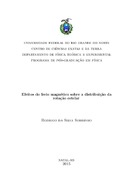Please use this identifier to cite or link to this item:
https://repositorio.ufrn.br/handle/123456789/20175| Title: | Efeitos do freio magnético sobre a distribuição da rotação estelar |
| Authors: | Silva Sobrinho, Rodrigo da |
| Advisor: | Freitas, Daniel Brito de |
| Keywords: | Rotação estelar;Vizinhança solar;Estatística não-extensiva;Freio magnético |
| Issue Date: | 21-May-2015 |
| Publisher: | Universidade Federal do Rio Grande do Norte |
| Citation: | SILVA SOBRINHO, Rodrigo da. Efeitos do freio magnético sobre a distribuição da rotação estelar. 2015. 71f. Dissertação (Mestrado em Física) - Centro de Ciências Exatas e da Terra, Universidade Federal do Rio Grande do Norte, Natal, 2015. |
| Portuguese Abstract: | O pioneiro trabalho proposto por Skumanich (1972) mostrou que a velocidade de rota¸c˜ao projetada m´edia < v sini > para estrelas do tipo solar obedece uma lei de decrescimento no tempo, dada por t −1/2 , onde t ´e a idade da estrela. Essa rela¸c˜ao ´e consistente com as teorias de perda de momentum angular atrav´es do vento estelar ionizado, que por sua vez est´a acoplado `a estrela pelo seu campo magn´etico. V´arios autores (e.g.: Silva et al. 2013 e de Freitas et al. 2014) analisaram as poss´ıveis correla¸c˜oes entre o decaimento rotacional e o perfil da distribui¸c˜ao de velocidade. Esses autores chegaram a uma simples rela¸c˜ao heur´ıstica, mas n˜ao constru´ıram uma passagem direta entre o expoente do decaimento rotacional (j) e o expoente da distribui¸c˜ao da velocidade rotacional (q). Todo esse cen´ario te´orico foi proposto usando uma eficiente e robusta mecˆanica estat´ıstica bem conhecida como mecˆanica estat´ıstica n˜ao-extensiva. A presente disserta¸c˜ao prop˜oe efetivamente fechar essa quest˜ao, elaborando um caminho te´orico para modificar as distribui¸c˜oes q-Maxwellianas em q-Maxwellianas com v´ınculos f´ısicos extra´ıdos da teoria do freio magn´etico. Para testar nossas distribui¸c˜oes, usamos um pacote de dados do cat´alogo de Geneva-Copenhagem Survey com aproximadamente 6000 estrelas F e G limitadas em idade. Como resultado, obtivemos que os expoentes da lei de decaimento e da distribui¸c˜ao seguem uma rela¸c˜ao similar `aquela proposta por Silva et al. (2013). |
| Abstract: | The pioneering work proposed by Skumanich (1972) has shown that the projected mean rotational velocity < v sini > for solar type stars follows a rotation law decreases with the time given by t −1/2 , where t is the stellar age. This relationship is consistent with the theories of the angular momentum loss through the ionized stellar wind, which in turn is coupled to the star through its magnetic field. Several authors (e.g.: Silva et al. 2013 and de Freitas et al. 2014) have analyzed the possible matches between the rotational decay and the profile of the velocity distribution. These authors came to a simple heuristic relationship, but did not build a direct path between the exponent of the rotational decay (j) and the exponent of the distribution of the rotational velocity (q). The whole theoretical scenario has been proposed using an efficient and strong statistical mechanics well known as non-extensive statistical mechanics. The present dissertation proposes effectively to close this issue by elaborating a theoretical way to modify the q-Maxwellians’ distributions into q-Maxwellians with physics links extracted from the theory of magnetic braking. In order to test our distributions we have used the GenevaCapenhagen Survey data with approximately 6000 F and G field stars limited by age. As a result, we obtained that the exponents of the decay law and distribution follow a similar relationship to that proposed by Silva et al. (2013). |
| URI: | https://repositorio.ufrn.br/jspui/handle/123456789/20175 |
| Appears in Collections: | PPGFIS - Mestrado em Física |
Files in This Item:
| File | Description | Size | Format | |
|---|---|---|---|---|
| RodrigoDaSilvaSobrinho_DISSERT.pdf | 2,42 MB | Adobe PDF |  View/Open |
Items in DSpace are protected by copyright, with all rights reserved, unless otherwise indicated.

